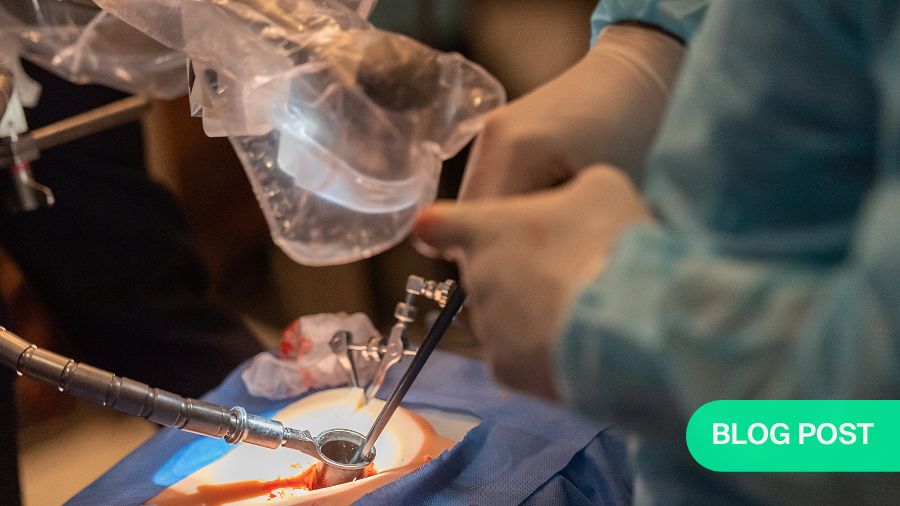Elderly patients benefit from minimally invasive TLIF as much as younger populations

Long-term outcomes of minimally invasive transforaminal lumbar interbody fusion (TLIF) in elderly patients are comparable to those in a younger patient population. This is important knowledge for the growing geriatric subpopulation amidst the trend towards value-based care and payment models. Our study confirming this was recognized with the Best E-Poster award at the Global Spine Congress 2021.
As the population ages, the number of elderly patients undergoing surgery for degenerative spinal conditions will continue to increase. Aging of the spine results in degenerative changes such as spinal stenosis and degenerative spondylolisthesis, which are among the leading causes of pain, functional impairment, and decline in quality of life in the geriatric population 1. TLIF is a prevalent surgical procedure to treat degenerative spondylolisthesis and spinal stenosis 2–4.
However, many elderly patients with degenerative spinal disorders are often not considered candidates for surgery because of medical comorbidities, ageism, or subjective impressions of a patient’s fitness for spinal surgery 5. Such patients are also often reluctant to undergo spinal surgery based on the belief that older patients are at a higher risk of having serious surgical complications or a poor outcome after surgery. Previous studies demonstrated a near-threefold increase in the risk of postoperative complications in patients 75 years or older compared with younger patients during open spinal surgery 6.
Long-term follow-up confirms improvement in pain, disability, and quality of life
The goal of MIS surgery is to reduce the disruption of soft tissues and improve postoperative recovery. MIS-TLIF has been shown to have comparable clinical outcomes and fusion rates to open TLIF 7–9, along with the often-cited benefits of less intraoperative blood loss 10, reduced postoperative pain 11, shorter hospital stay 12, and lower complication rates 13,14. However, data on long-term PROs remains sparse, especially in an elderly population.
We compared the clinical and radiological outcomes between elderly patients and younger controls undergoing MIS TLIF at a minimum follow-up of five years. Patients who underwent a primary single-level MIS TLIF for degenerative spondylolisthesis were retrospectively reviewed and stratified into two cohorts: elderly (≥70 years) and controls (<70 years). The cohorts were matched in a 1:3 ratio for sex, body mass index, American Society of Anesthesiologists (ASA) class, comorbidities, and preoperative patient-reported outcomes (PROs) using propensity scoring. Complications, length of stay and readmissions were recorded. PROs including the Oswestry Disability Index (ODI), 36-Item Short-Form Physical Component Score (SF-36 PCS), Mental Component Score (SF-36 MCS), Visual Analogue Scale (VAS) back pain, and VAS leg pain were compared at six months, two years, and five years. Satisfaction was assessed using the North American Spine Society (NASS) questionnaire. In addition, radiographic fusion, and adjacent segment degeneration (ASD) were assessed. Revision procedures were recorded, and mean follow-up was 7.2 ± 3 years.
Elderly patients undergoing minimally invasive (MIS) transforaminal lumbar interbody fusion (TLIF) had a longer length of stay (4.7 ± 5.8 days vs. 3.3 ± 1.4 days, p=0.035) and more readmissions (10% vs 1%, p=0.019), but there was no difference in operative time, transfusions, complications, or discharge disposition. Importantly, older patients achieved comparable improvements in pain, disability and quality of life that were sustained for up to five years, with no longer-term deterioration. Both cohorts demonstrated similar satisfaction rates (93% in elderly vs. 91% in controls, p=0.703) and achievement of minimal clinically important difference for each PRO. Radiographic fusion was 94% and 97% in the control and elderly groups, respectively (p=0.605), while 40% and 33% had radiological ASD (p=0.503). There were three revisions (3.3%) in the control group (two for ASD and one for screw loosening) but none in the elderly group (p=0.311).
One of the benefits of my previous practice in a small country (Singapore) is the ability to obtain a long duration of follow-up for most patients. As the population ages and we transition towards value-based payment models, we strived to address this question in our research study. Elderly patients were just as likely to benefit at five years postop, supporting the long-term efficacy of the MIS approach in this growing subpopulation.
Further reading and references
- Rosenberg NJ. Degenerative spondylolisthesis. Predisposing factors. J Bone Jt Surg. 1975;57(4):467-474. doi:10.2106/00004623-197557040-00004
- Weinstein JN, Lurie JD, Tosteson TD, et al. Surgical versus Nonsurgical Treatment for Lumbar Degenerative Spondylolisthesis. N Engl J Med. 2007;356(22):2257-2270. doi:10.1056/nejmoa070302
- Weinstein JN, Tosteson TD, Lurie JD, et al. Surgical versus Nonsurgical Therapy for Lumbar Spinal Stenosis. N Engl J Med. 2008;358(8):794-810. doi:10.1056/nejmoa0707136
- Goh GS, Tay YWA, Yue WM, Guo CM, Tan SB, Chen JLT. What Are the Patient-reported Outcomes, Complications, and Radiographic Results of Lumbar Fusion for Degenerative Spondylolisthesis in Patients Younger Than 50 Years? Clin Orthop. 2020;478(8):1880-1888. doi:10.1097/CORR.0000000000001252
- Rosen DS, O’Toole JE, Eichholz KM, Huo D, Sandhu FA, Fessler RG. Minimally Invasive Lumbar Spinal Decompression in the Elderly. Neurosurgery. 2007;60(3):503-510. doi:10.1227/01.neu.0000255332.87909.58
- Deyo RA, Ciol MA, Cherkin DC, Loeser JD, Bigos SJ. Lumbar Spinal Fusion. Spine. 1993;18(11):1463-1470. doi:10.1097/00007632-199309010-00010
- Peng CWB, Yue WM, Poh SY, Yeo W, Tan SB. Clinical and Radiological Outcomes of Minimally Invasive Versus Open Transforaminal Lumbar Interbody Fusion. Spine. 2009;34(13):1385-1389. doi:10.1097/brs.0b013e3181a4e3be
- Goldstein CL, Macwan K, Sundararajan K, Rampersaud YR. Comparative Outcomes of Minimally Invasive Surgery for Posterior Lumbar Fusion: A Systematic Review. Clin Orthop Relat Res. 2014;472(6):1727-1737. doi:10.1007/s11999-014-3465-5
- Sidhu GS, Henkelman E, Vaccaro AR, et al. Minimally Invasive versus Open Posterior Lumbar Interbody Fusion: A Systematic Review. Clin Orthop Relat Res. 2014;472(6):1792-1799. doi:10.1007/s11999-014-3619-5
- Rahman M, Summers L, Richter B, Mimran R, Jacob R. Comparison of Techniques for Decompressive Lumbar Laminectomy: the Minimally Invasive versus the “Classic” Open Approach. Min - Minim Invasive Neurosurg. 2008;51(2):100-105. doi:10.1055/s-2007-1022542
- Podichetty VK, Spears J, Isaacs RE, Booher J, Biscup RS. Complications Associated With Minimally Invasive Decompression for Lumbar Spinal Stenosis. J Spinal Disord Tech. 2006;19(3):161-166. doi:10.1097/01.bsd.0000188663.46391.73
- Mobbs RJ, Li J, Sivabalan P, Raley D, Rao PJ. Outcomes after decompressive laminectomy for lumbar spinal stenosis: comparison between minimally invasive unilateral laminectomy for bilateral decompression and open laminectomy. J Neurosurg Spine. 2014;21(2):179-186. doi:10.3171/2014.4.spine13420
- Hu W, Tang J, Wu X, Zhang L, Ke B. Minimally invasive versus open transforaminal lumbar fusion: a systematic review of complications. Int Orthop. 2016;40(9):1883-1890. doi:10.1007/s00264-016-3153-z
- Goldstein CL, Macwan K, Sundararajan K, Rampersaud YR. Perioperative outcomes and adverse events of minimally invasive versus open posterior lumbar fusion: meta-analysis and systematic review. J Neurosurg Spine. 2016;24(3):416-427. doi:10.3171/2015.2.spine14973
- Spinal News International interviewed Graham Goh during GSC 2022
Disclaimer
The articles included in the AO Spine Blog represent the opinion of individual authors exclusively and not necessarily the opinion of AO Spine or AO Foundation.


